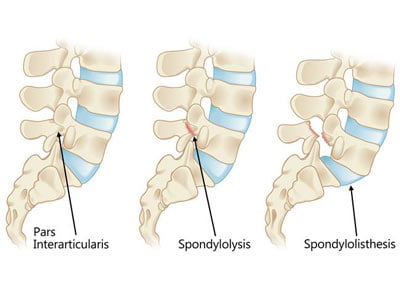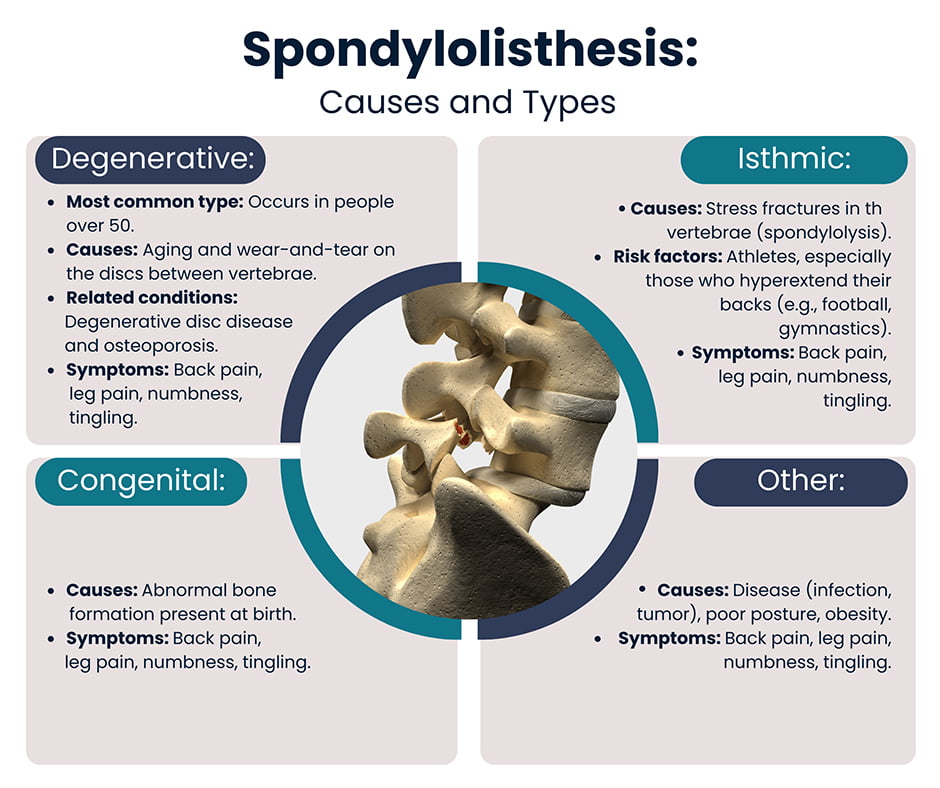With so many different conditions that can lead to back pain, you must receive a correct diagnosis before you can get the treatment that effectively targets your discomfort. In New York, you can turn to Pain Management NYC, which has the most advanced diagnostic equipment available in the country. This pain treatment clinic boasts the best back pain specialists in Midtown, and they successfully treat spondylolisthesis. Spondylolisthesis is one of those conditions that leaves you with continued pain and limits your activities and quality of life. Don’t suffer any longer; call today for an appointment.
Spondylolisthesis is a form of structural back pain, in which one vertebra slips out of place onto the bone below it. If it slips too far, it causes pressure on a nerve, resulting in back pain. If you’re experiencing lower back pain, upper pain or middle back pain, you may need spondylolisthesis treatment. Visit the best back pain clinic in Manhattan, Pain Management NYC, for a firm diagnosis and effective treatment options.
You’ll find the physicians are among the top pain management doctors in NYC. They work quickly to correctly diagnose the source of your discomfort. With an effective and successful spondylolisthesis treatment plan, you’re able to return to an active lifestyle as soon as possible.
Symptoms of Spondylolisthesis
 Some people who have spondylolisthesis have no symptoms at all. When you do experience symptoms, they can range from mild to severe. The most common complaint is lower back pain that spreads across your back and feels like a strained muscle or pinched nerve.
Some people who have spondylolisthesis have no symptoms at all. When you do experience symptoms, they can range from mild to severe. The most common complaint is lower back pain that spreads across your back and feels like a strained muscle or pinched nerve.
Your lower back pain may radiate to the back of your thighs or your buttocks. It tends to get worse with activity and slightly better if you rest. Back stiffness and leg pain may cause difficulty with walking or standing. You may also experience numbness or weakness in your legs. Pain and numbness may spread down one leg to your foot. Symptoms of spondylolisthesis often mimic other back problems, which is why you need to get a thorough exam from a top back pain specialist.
What Causes Spondylolisthesis?
There are different types of spondylolisthesis, and each type has a different cause. The different types of the condition include:
- Degenerative spondylolisthesis. This is the most common form of spondylolisthesis. The aging process causes wear-and-tear on the discs between vertebrae, making them less able to prevent vertebrae slippage. Degenerative disc disease or osteoporosis can lead to this type of spondylolisthesis, which usually affects people over the age of 50. So see a back pain doctor when your symptoms first appear.
- Isthmic spondylolisthesis. This type of spondylolisthesis develops from spondylolysis, a condition that causes stress fractures in the vertebrae. When these small fractures weaken the bones, they can slip out of place. Athletes — especially those engaged in football, weight-lifting and gymnastics — are at risk of developing multiple stress fractures caused by hyperextending the back. Accidents that lead to traumatic fractures also can cause the condition.
- Congenital spondylolisthesis. This form of spondylolisthesis is present at birth and is caused by abnormal bone formation. The genetic weakness, called pars interarticularis, may not be diagnosed until you start experiencing back pain.
- Slippage can also occur when the spine is weakened by disease, such as an infection or a tumor.
- Poor posture and obesity can also increase stress on the vertebrae. As interventional physicians, the top pain doctors at Pain Management in New York provide recommendations about changes you can make to alleviate further stress on your back.

How to Treat Spondylolisthesis
The goal of interventional treatment for spondylolisthesis is to relieve pain and inflammation, while promoting healing. Your pain doctor may recommend a back brace for a period of time to limit movement, which helps your back heal. Physical therapy may help stretch and strengthen your lower back muscles in the area of your back pain. Other examples of treatment for spondylolisthesis include:
- Lumbar epidural steroid injections. Injections into the epidural space inside the spinal column can reduce inflammation and improve your range of motion.
- Nerve block injections. These injections relieve pain and give your back time to heal and respond more effectively to other treatments.
- Spinal cord stimulator. This treatment relies on electrical signals to reduce the amount of pain you experience.
- Radiofrequency ablation. This form of treatment uses an electric current to heat a small area of nerve tissue to stop it from sending pain signals.
- Other minimally invasive surgical procedures. Techniques such as a lumbar discectomy are sometimes required to give you permanent relief.
Symptoms of spondylolisthesis improve with treatment. Your pain specialists thoroughly evaluate your condition with the most up-to-date equipment in the industry to find the best approach for your spondylolisthesis treatment. Contact the experts at Pain Management NYC to feel better and get back to your normal routines.

Leon Reyfman, MD, is a top-rated, best-in-class interventional pain management doctor. He is a nationally recognized pain relief specialist and is among the top pain care doctors in New York City and the country. He is an award-winning expert and contributor to prominent media outlets.
Dr. Leon Reyfman has been recognized for his thoughtful, thorough, modern approach to treating chronic pain. He has been named a “top pain management doctor in New York” and one of “America’s Top Doctors™” for advanced sports injury treatments. Among other accolades, he was voted by peers as a “Castle Connolly Top Doctors™” and “New York Super Doctors™”. Dr. Leon Reyfman was a part of the medical team at the 2016 Summer Olympic Games in Rio de Janeiro, Brazil.
